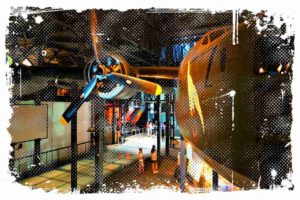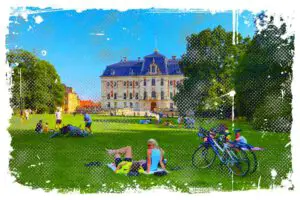The hall was added to the UNESCO list in 2006. The hall was a milestone in the history of construction, built of reinforced concrete. It stands proudly in Wroclaw, where it was built between 1911 and 1913 as part of the Wroclaw Centennial Exhibition. At that time, the Germans presented the economic and historical achievements of Lower Silesia. The project was inspired by the 100th anniversary of the „To My People” proclamation, in which King Frederick William III called on his people to resist Napoleon’s army. The competition for the construction of the hall was the result of the submission and evaluation of 43 designs.

The winner was Max Berg with his circular design featuring four apses. His design was crowned with a 67m dome and a steel and glass lantern. The hall was able to seat more than 6,000 people in its spacious auditorium. It was also home to the largest organ in the world, with 222 stops and almost 17,000 pipes. Some of these pipes can still be admired in the Wroclaw Arch Cathedral and others in Czestochowa Jasna Gora. The cost of the construction of this masterpiece was a whopping 2 million German marks.
Centennial Hall opened its doors on May 20, 1913, attended by Prince Frederick William. Over the years, the hall „has seen” a lot. During the Nazi era, the hall was used for party rallies, and in the People’s Republic of Poland, the hall was the venue for events like the Restoration Exposition, the World Intellectual Congress, and even the European Men’s Basketball Championship. More recently, operas by Wagner and Verdi have been performed here.
Please check other interesting UNESCO Sites, as they might be nearby: Exploring Poland’s Cultural Riches: A Guide to UNESCO Cities
↳ PRO TIP: Do you like traveling? Then before you buy any ticket or book an attraction, check if it's available in this worldwide Viator Database. You may save a lot of money and time. No need to thank me :)
Centennial Hall’s First Even Ever
The first event held in the hall was the Centennial Exhibition. It presented the history and everyday life during the Napoleonic Wars, as well as the technical and cultural development of Lower Silesia one hundred years later. Many important events have taken place there over the years, including the World Congress of Spirituals and the Exhibition of Recovered Lands in 1948, the visits of Pope John Paul II in 1997, the Dalai Lama in 2010, and the European Cultural Congress in 2011. If you want to find out more about calendar of current events, check out the Hall’s web site.
- Hall Pictures and Google Maps Location: Here
The hall is located in Szczytnicki Park
The hall is surrounded by several structures, such as the 650-meter-long Pergola, designed by Hans Poelzing. The pergola features a multimedia fountain with a different soundtrack for each season, from spring to fall. Other sites include the Pavilion of the Four Domes, the Spire, the Japanese Garden, and the Zoo. On the other hand, there’s a small wooden church of St. John of Nepomuk. It’s the only remaining piece from the cemetery art exhibition of 1913. In order to raise awareness about the preservation of historical monuments, the church was moved from Opole and rebuilt in Szczytnicki Park.
Knowledgeable
- Parking in the hall’s underground garage costs 5 PLN per hour, with a maximum charge of 50 PLN. On weekends, holidays, and every day in July and August, it’s 6 zloty per hour, with a maximum charge of 60 zloty.
- To see the inside of the Centennial Hall, you will walk through the Discovery Center, which presents the history of the hall and how it influenced future architectural designs through interactive exhibits.
- Due to the many events taking place in the hall, the opportunity to see the inside may be limited. However, you can still visit the interactive Discovery Center.
Fascinating Information about Centennial Hall
The Spire was designed by Stanislaw Hempel. It was erected in front of the Centennial Hall in 1948 for the Exhibition of Recovered Territories. At the top of the tower, there were mirrors for the reflection of spotlights and the illumination of the whole city. Unfortunately, the mirrors were smashed in a storm, and at the end of the exhibition, they were taken down by a pair of adventurous college students.
The restored pavilion is now the Wroclaw Convention Center. It was designed by none other than Max Berg himself. The pavilion was renovated and expanded in 2009–2010. Originally, it had a lantern and a dome on the roof, but due to financial constraints, they were made of perishable materials and were taken down in the 1930s.
Color of the Hall
It turns out Centennial Hall wasn’t always gray! The paint that once covered the hall had been washed away by more than 100 years of weathering. Remnants of the original paint were found in hidden spots between the hall and the Wroclaw Congress Center. After careful chemical analysis, the exact shade was discovered. This color was used during the renovation of the hall’s facade in 2010.
German Systems
When the Centennial Hall was renovated inside, the original mechanical ventilation system was replaced, revealing four working German engines manufactured by Krupp. This discovery was a testament to the high quality and durability of the technology used in the construction of the building.
Max Berg did not include ornamentation in the design of the Centennial Hall, except for the bas-relief above the main entrance, created by Alfred Vocke. The sculpture was, however, destroyed after the war and does not exist any more.
Largest Organs in Poland
The world’s largest organ, with 15,133 pipes, was installed in Centennial Hall in 1913. Astonishingly, it survived the war unscathed, but unfortunately, after 1945, looters stripped it of all many pipes. The remaining parts of the organ, including the intact console, were moved to the Wroclaw Cathedral in the years 1950 – 1952. The missing parts were filled in with those from the organ of the Gustav Adolf Evangelical Church in Wroclaw. Despite the loss, the great organ of the Centennial Hall continues to make beautiful music. Today it’s the largest organ in Poland, with 150 stops and 13,207 pipes.
You may be surprised to know that the columns on the side of Exhibition Street were part of the covered courtyards that served as the main entrance to the Exhibition Grounds in 1925. Today, these columns stand tall, connecting the walls of the Institute for Automation of Energy Systems (IASE).
Many Uses of the Hall
Centennial Hall had a dark past before World War II. It was used to hold Nazi rallies attended by none other than Adolf Hitler. In the 1990s, the hall became a basketball arena where Slask Wroclaw celebrated its greatest victories. In 1997, the Hall was honored to host the Eucharistic Congress in the presence of Pope John Paul II. And more recently, the Hall has once again become the center of major sporting events such as the Eurobasket tournament and the World Volleyball Championships.
Opening Hours and Ticket Price
Centennial Hall is open to visitors as follows:
- April through October: Monday through Friday 9am to 6pm, Saturday 9am to 7pm, Sunday 9am to 6pm
- November through March: Monday to Friday 9 am to 5 pm, Saturday and Sunday 9 am to 5 pm.
Tickets cost 12 PLN for adults and 9 PLN for kids. Parking is available for an additional charge.
Centennial Hall is located at:
1 Wystawowa St., Wroclaw, Poland
For more information, please call the hall at (71) 347-51-51. You can also visit their website at http://halastulecia.pl.
Bibliography
- https://halastulecia.pl/
- https://pl.wikipedia.org/wiki/Hala_Stulecia_we_Wroc%C5%82awiu
- https://turystyka.wp.pl/hala-stulecia-6366402501420673c




